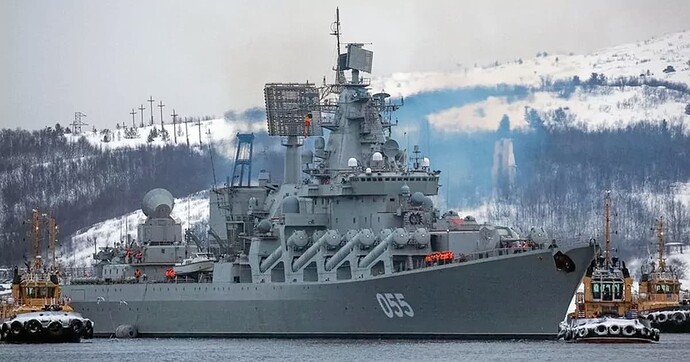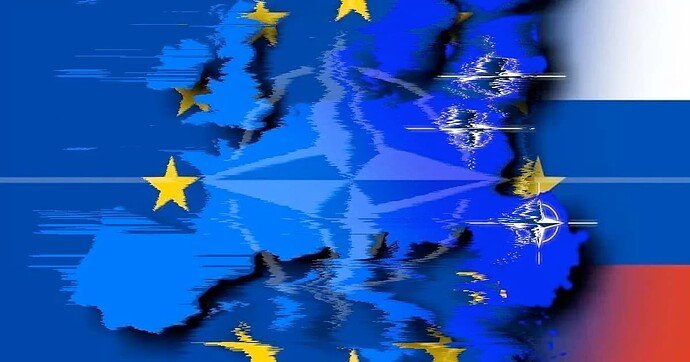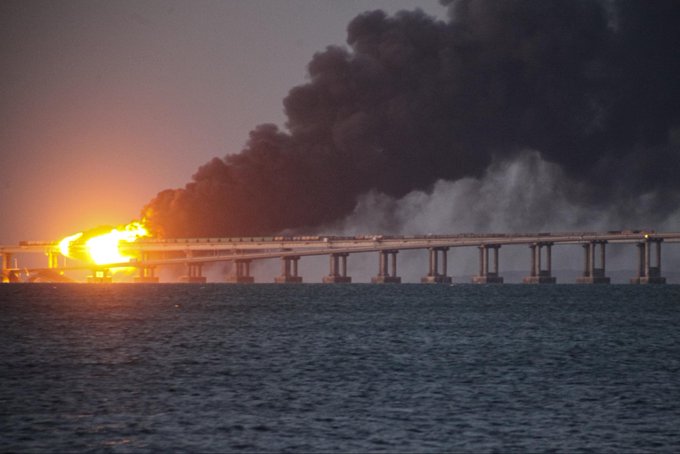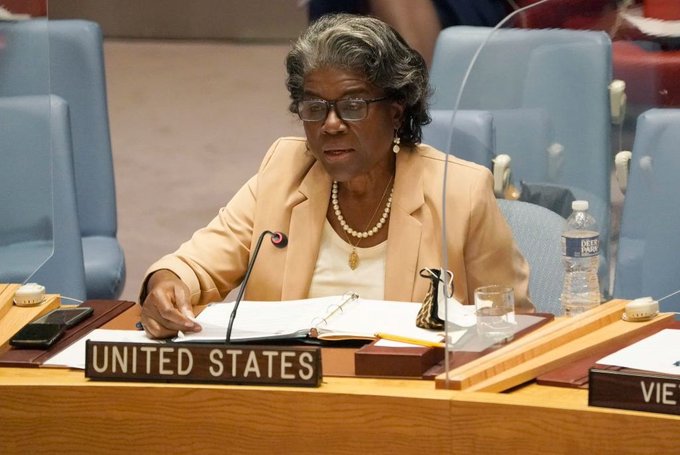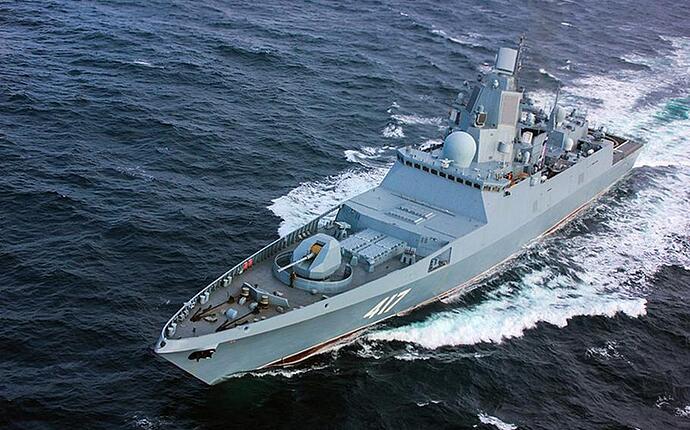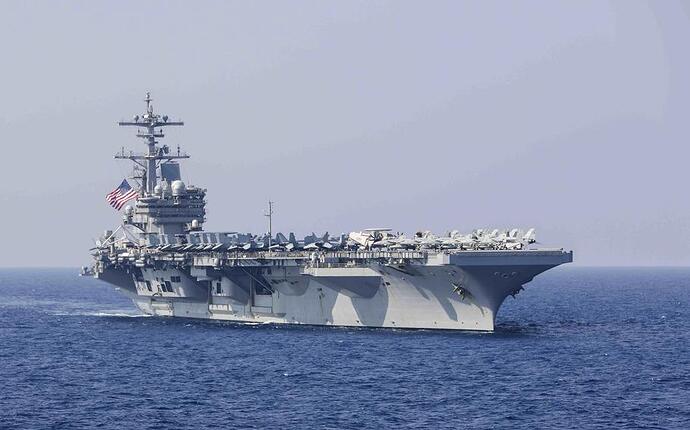SCOTT RITTER - RUSSIA'S OBJECTIVES IN UKRAINE
Ukraine Short On Ammo With Russia Gaining, Despite West’s Billions
Please read and share this article on Gibraltar Messenger. Thank you.
Norway: The Russian Northern Fleet set sail with nuclear missiles
Please read and share this article on Gibraltar Messenger. Thank you.
A US-Led ‘Coalition of the Willing’ Foreshadows the Splintering of NATO
Please read and share this article on Gibraltar Messenger. Thank you.
NATO Preparing for World War III
Perhaps NATO is starting to wake up. They now realize that they may have to wage war on two fronts simultaneously. NATO is considering what they call a defensive move which is an “Article 5 conflict” but also an “out-of-area” battle. This is showing that NATO is no longer what it was supposed to have been – the defense of Europe against a Soviet invasion that never took place. The “out-of-area” is none other than China invading Taiwan. NATO is simply usurping power that it was never authorized to carry out. This, Article 5 event is an attack on a NATO member, whereas the “out-of-area” is a non-NATO member.
Clearly, we are witnessing how once power is taken, it is always abused. NATO has always billed itself as a “defensive alliance” but it has embarked on an offensive posture with Ukraine and now even Taiwan. Don’t forget, NATO joined the hostilities in Yugoslavia during the 1990s and again with Libya in 2011. Many have viewed that NATO has been usurped by the American Neocons to further their agenda of manipulating US foreign policy. That is becoming self-evident by even considering war with China and Russia.
All our sources confirm that the US has demanded that Brussels increase its defense expenditures. Everyone is expected to chip in 2% of GDP – ASAP. The US is now also expecting that it will have to fight on two fronts against both China and Russia. The Neocons are demanding higher Pentagon budgets now. They simply want war and we have no right to vote on any of this confirming once again, we do not live in a democracy, but in a dictatorship masquerading as a republic.
You NEVER go to war without weighing the gains against the losses. What is taking place is the very same bankers that tried to take over Russia I wrote about in the 2000 Plot to Seize Russia, are back after 23 years and they are pleading to wage war and are licking their lips once again at seizing all the natural resources of Russia from gold and diamonds, to energy and uranium. The problem, they may not survive their own greed this time.
https://twitter.com/MilkyWa34808762/status/1627326937885716480

Unusual installation ‘History always repeats itself’ appeared in Moscow
Unusual installation "History always repeats itself" appeared in #Moscow
It depicts footage of ‘the Great Patriotic War’ and the date February 21, 2023
It is on this day that #Russian President #VladimirPutin will address Federal Assembly with Message
https://twitter.com/WarMonitors/status/1627315432481865731
War Monitor
The Russian Investigative Committee has just received confirmation that the Ukrainian special services organized the attack on the Crimean bridge Why is this important? It could give Putin a legal reason to declare war on Ukraine in his upcoming address.
https://twitter.com/Flash_news_ua/status/1627422268585385984
The transfer of lethal weapons by China to Russia for use in Ukraine will become a "red line" in relations between Washington and Beijing. This is reported by CNN with reference to a statement by US Permanent Representative to the UN Linda Thomas-Greenfield.
@Flash_news_ua
NATO Double Downs for WW3; while Hungary cautions Europe.
Please read and share this article on Gibraltar Messenger. Thank you.
The defeat of Ukraine does not mean the end of the war
Please read and share this article on Gibraltar Messenger. Thank you.

Putin warns of second war in Europe Russia claims Ukraine pumping Moldovan...

50 Hours In A Country That Doesn't Exist On A Map (Transnistria)
Russian fleet’s ‘aggressive attitude’ in Mediterranean heightens risks, Italy’s naval chief says
The Russian frigate Admiral Gorshkov, armed with hypersonic missiles, is expected to head to the Mediterranean Sea, following training with the South African and Chinese navies. Adm. Enrico Credendino, the Italian navy chief of staff, recently told the country's parliament that a buildup of Russian ships in the Mediterranean is increasing the risk of an incident. (Russian Ministry of Defense) - [below]
Russian navy ships are transiting the Mediterranean Sea in numbers not seen even in the Cold War, increasing the risk of an incident with NATO forces in the normally stable region, Italy’s top naval officer said this week.
That increase coincides with an “aggressive attitude” shown by Russian naval forces similar to their posture in the Baltic Sea, Adm. Enrico Credendino said Thursday, according to a report by the Italian news agency Ansa.
And the impending arrival of the Russian frigate Admiral Gorshkov, armed with hypersonic missiles, into the Mediterranean after completion of exercises in Africa could further aggravate an already “complex and turbulent” situation, Credendino said in the Ansa report.
The active part of those exercises, which include China and South Africa, is scheduled to end Monday, the Russian state news agency RIA reported Wednesday.
"The risk of an incident is possible, and when there is an incident of this nature, you never know where you might end up,” Credendino said, according to the Ansa report.
However, Credendino also said Russian naval activity in the region, an effect of the war in Ukraine, was not a direct threat to national territory, Ansa reported.
And allies have repeatedly upheld the right of all nations to transit peacefully through international waters.
U.S. Naval Forces Europe-Africa/U.S. 6th Fleet did not answer Stars and Stripes’ questions Friday about Russian naval presence in the Mediterranean.
The aircraft carrier USS George H.W. Bush sails the Mediterranean Sea in January 2023. Russian naval presence in the sea has increased to levels greater than those normally seen during the Cold War, Adm. Enrico Credendino, the Italian navy chief of staff, recently told the country's parliament. (Kenneth Blair/U.S. Navy) - [below]
U.S. officials previously have said that interactions with the Russian navy occur with some frequency and are typically safe. But in November 2022, a Russian ship’s encounter in the Mediterranean with the George H.W. Bush Carrier Strike Group was deemed unprofessional by a U.S. admiral, who didn’t go into details.
The same month, two Russian fighter jets approached NATO ships in the Baltic Sea at an altitude of about 300 feet and a distance of 80 yards, ignoring query communications, according to a NATO statement.
Open source intelligence analysts recently posted on Twitter and other social media sites that Russia’s naval fleet in the Mediterranean appears to be increasingly active. Previous reports indicated that much of the fleet appeared to regularly be in port in Tartus, Syria, over the past year.
“The mass deployment was most likely done in response to the presence of the U.S. Navy carrier action group centered on the aircraft carrier USS George H.(W.) Bush,” former Belgian navy officer Frederik Van Lokeren posted Feb. 18 to his blog.
Those Russian forces include at least one Kilo-class submarine and eight other warships, such as frigates, corvettes and tankers, according to Van Lokeren.
Credendino also noted increased Russian naval activity in the Black Sea, an observation supported by open source analysts in recent weeks.
He described the Mediterranean as crowded, with four allied groups — Italian, American, French and Spanish — operating in the area.
USNI reported Tuesday that the George H.W. Bush strike group remained in the eastern Mediterranean after being ordered there in response to the Feb. 6 earthquake in Turkey.
The group includes destroyers USS Nitze, USS Delbert D. Black, USS Farragut and USS Truxtun in addition to the cruiser USS Leyte Gulf and Carrier Air Wing 7.
Analysts also have likened the NATO naval presence in the Mediterranean, which includes the Ionian and Aegean seas, to that of the Cold War era.
That presence was made more notable in December 2021, when Defense Secretary Lloyd Austin ordered the USS Harry S. Truman to remain in the Mediterranean amid Russia’s military buildup and subsequent invasion of Ukraine.
The Truman Carrier Strike Group stayed there until August 2022, when the Bush came on patrol.
DOUGLAS MACGREGOR - THE OFFENSIVE IN UKRAINE: WHAT HAPPENS NEXT?
NATO considering deployment of up to 300,000 troops on border with Russia
NATO is discussing the need to strengthen the eastern borders with Russia by concentrating equipment and a military contingent of up to 300,000 soldiers, which should prevent Russia from expanding the war beyond Ukraine.
Details: Politico writes that NATO intends to stop Russia if it decides to expand the war beyond Ukraine. Because of this, the Alliance is talking about strengthening its eastern borders and the need to send up to 300,000 troops to the border.
Such actions will require coordination and great efforts from the 30 NATO members to provide soldiers, training facilities, large quantities of weapons, equipment and ammunition.
However, the news outlet emphasises that coordination may be challenging, as many allies are already concerned about their own insufficient ammunition stocks, which take time and money to replenish.
Politico writes that NATO military leaders are to submit updated regional defence plans. Alliance officials are putting forward the idea that its borders with Russia should be guarded by up to 300,000 troops, the news outlet reports.
It is noted that the first echelon of NATO troops may consist of about 100,000 soldiers, ready to deploy within 10 days. It may include troops from Poland, Norway, Estonia, Latvia and Lithuania.
The second echelon of troops, Politico writes, will support these soldiers, ready to be deployed within 10-30 days from countries such as Germany.
NATO is racing to arm its Russian borders. Can it find the weapons?
Allies are worrying about dwindling war chests just as NATO seeks commitments for new stockpiles and troops along the eastern flank.
Add NATO’s military planners to the list of those concerned about having enough shells.
In the coming months, the alliance will accelerate efforts to stockpile equipment along the alliance’s eastern edge and designate tens of thousands of forces that can rush to allies’ aid on short notice — a move meant to stop Russia from expanding its war beyond Ukraine.
To make that happen, though, NATO must convince individual countries to contribute various elements: Soldiers, training, better infrastructure — and, most notably, extensive amounts of pricey weapons, equipment and ammunition.
With countries already worried about their own munitions stockpiles and Ukraine in acute need of more shells and weapons from allies, there is a risk that not all NATO allies will live up to their promises to contribute to the alliance’s new plans.
“If there’s not somebody hosting the potluck and telling everybody what to bring, then everyone would bring potato chips because potato chips are cheap, easy to get,” said James J. Townsend Jr., a former U.S. deputy assistant secretary of defense for European and NATO policy.
“Nations,” he added, “would rather bring potato chips.”
It’s a challenge NATO has faced in the past, and one that experts fear could become a persistent problem for the Western alliance as Russia’s war drags into a second year. While the U.S. and EU are making plans to source more weapons — fast — the restocking process will inevitably take time.
That could run into NATO’s aspirations. Military leaders this spring will submit updated regional defense plans intended to help redefine how the alliance protects its 1 billion citizens.
The numbers will be large, with officials floating the idea of up to 300,000 NATO forces needed to help make the new model work. That means lots of coordinating and cajoling.
“I think you need forces to counter a realistic Russia,” said one senior NATO military official, underscoring the need for significantly “more troops” and especially more forces at “readiness.”
A push for ‘readiness’
There are several tiers of “readiness.”
The first tier — which may consist of about 100,000 soldiers prepared to move within 10 days — could be drawn from Poland, Norway and the Baltic states (Estonia, Latvia and Lithuania), said Heinrich Brauß, a former NATO assistant secretary general for defense policy and force planning. It may also include multinational battlegroups the alliance has already set up in the eastern flank.
A second tier of troops would then back up those soldiers, ready to deploy from countries like Germany in between 10 to 30 days.
But the process could get tricky. Why? Because moving so quickly, even given a month, requires lots of people, equipment and training — and lots of money.
Some militaries will have to up their recruitment efforts. Many allies will have to increase defense spending. And everyone will have to buy more weapons, ammunition and equipment.
Ben Hodges, former commander of U.S. Army Europe, said that “readiness” is “basically, do you have all the stuff you’re supposed to have to do the mission assigned to a unit of a particular size?”
“An artillery battalion needs to shoot X number of rounds per year for planning purposes in order to maintain its level of proficiency,” he said. A tank battalion needs to hit targets, react to different situations and “demonstrate proficiency on the move, day and night, hitting targets that are moving.”
“It’s all very challenging,” he said, pointing to the need for training ranges and ammunition, as well as maintaining proficiency as personnel changes over time. “This obviously takes time and it’s also expensive.”
And that’s if countries can even find companies to produce quality bullets quickly.
“We have tended to try to stockpile munitions on the cheap … it’s just grossly inadequate,” said Stacie Pettyjohn, director of the defense program at the Center for a New American Security. “I think the problems that our allies have in NATO are even more acute because many of them often rely on the U.S. as sort of the backstop.”
NATO Secretary-General Jens Stoltenberg, meanwhile, has repeatedly said that allies have stepped up work on production in recent months — and that the alliance is working on new requirements for ammunition stockpiles.
But he has also acknowledged the problem.
“The current rate of consumption compared to the current rate of production of ammunition,” he said in early March, “is not sustainable.”
The big test
Once NATO’s military plans are done, capitals will be asked to weigh in — and eventually make available troops, planes, ships and tanks for different parts of the blueprints.
A test for NATO will come this summer when leaders of the alliance’s 30 member countries meet in Lithuania.
“We are asking the nations — based on the findings we have out of our three regional plans — what we need to make these plans … executable,” said the senior NATO military official, who spoke on condition of anonymity to discuss sensitive planning.
“I think the most difficult thing,” the official added, “is the procurement.”
Some allies have already acknowledged that meeting NATO’s needs will take far more investment.
“More speed is needed, whether in terms of material, personnel or infrastructure,” German Colonel André Wüstner, head of the independent Armed Forces Association, told the newspaper Bild am Sonntag.
The German military, for instance, is carrying out its assigned missions, he said, “but that is nothing compared to what we will have to contribute to NATO in the future.”
And while Berlin now has a much-touted €100 billion modernization fund for upgrading Germany’s military, not a single cent of the money has been spent so far, German Parliamentary Commissioner for the Armed Forces Eva Högl said earlier this week.
Underpinning the readiness issue is a contentious debate over defense investments.
In 2014, NATO leaders pledged to aim to spend 2 percent of their economic output on defense within a decade. At the Vilnius summit in July, the leaders will have to decide on a new target.
“Two percent as floor” seems to be the “center of gravity” in the debate at the moment, said one senior NATO official, while cautioning that “2 percent would not be enough for everybody.”
A second issue is the contribution balance. Officials and experts expect the majority of high-readiness troops to come from European allies. But that means European capitals will need to step up as Washington contemplates how to address challenges from China.
The response will show whether NATO is serious about matching its ambitions.
“It’s hard to make sure you remain at the top of your military game during peace when there’s not a threat,” said Townsend, the former U.S. official. NATO, he said, is “in the middle” of a stress test.
“We’re all saying the right things,” he added. “But will we come through at the end of the day and do the right thing? Or are we going to try to get away with bringing potato chips to the potluck? The jury’s out.”
Douglas Macgregor: “Russia IS WIPING THEM OUT, THIS IS IT” in Exclusive Interview
by tts-admin | Mar 29, 2023
Red Pilled TV — March 38, 2023

Douglas Macgregor Russia IS WIPING THEM OUT THIS IS IT in Exclusive Interview
Douglas Macgregor: “Russia IS WIPING THEM OUT, THIS IS IT” in Exclusive Interview
UK, US SPECIAL FORCES IN UKRAINE
U.S.-LED NATO FACES ANGER IN BULGARIA; THOUSANDS TELL GOVT TO ADOPT WAR NEUTRALITY | WATCH
Anti-NATO rallies rocked the cities of a major NATO and EU member. Thousands of Bulgarians hit the streets in protest of the western military alliance, calling on their government to adopt a neutral stand in the Russia-Ukraine conflict. Similar protests also took place in German cities earlier last week.
Russia is clearly preparing its western border areas to be attacked by NATO.
Russia Pulls 3,000 More Tanks from Storage - But NOT ALL Going to Ukraine
This past weekend, beginning last Friday, Russia pulled another three thousand tanks from various storage depots and began loading them on trains. Those trains are NOT all going toward Ukraine; they're heading to Russia's western Border areas.
In particular, areas near Murmansk/Kola, not too far from the Norway/Finland Border, North/northwest of St. Petersburg, near Vyborg, which is not too far from the Finland Border, then more near Kingisepp, near Narva, Estonia (from which it's a straight line to Estonia's Capital, Tallin.
Several trains headed toward Pskov, near the borders of southern Estonia, and northern Latvia.
Several other trains are headed toward Kursk and Belgorad.
Here is video of just ONE of those tank trains: [video embedded in article]
Those last trains heading near Kursk and Belgorad seem to indicate Russia is bolstering areas where, perhaps a Ukraine Counter-Offensive may attack.
The other trains, however, point to a very different situation emerging: Russia is clearly preparing its western border areas to be attacked by NATO.
RED ALERT! NATO CLOSING BORDERS. S-400'S AND NUKES ARE MOBILE, AIR RAIDS NOW, MAJOR ISSUE IN TAIWAN

